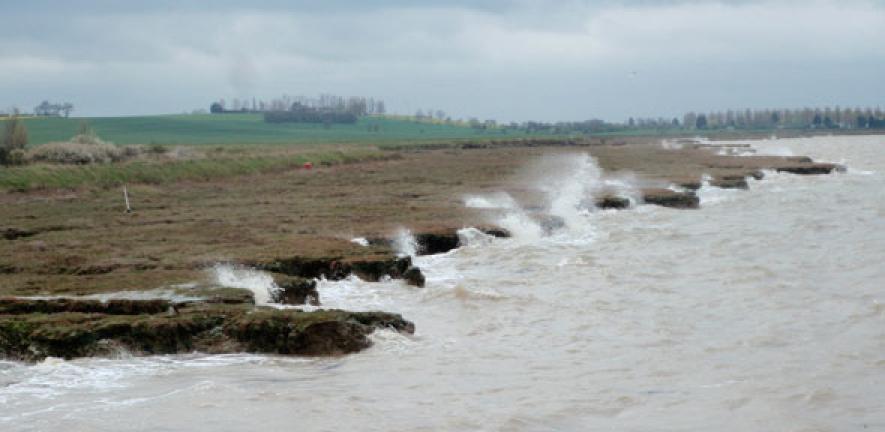
Study finds that natural flood defences such as salt marshes can reduce the height of damaging waves in storm surge conditions by close to 20%.
Study finds that natural flood defences such as salt marshes can reduce the height of damaging waves in storm surge conditions by close to 20%.
Even in extreme conditions, salt marshes are a vital defence for our coastlines
Iris Möller
The effectiveness of salt marshes – wetlands which are flooded and drained by tides – in protecting coastal areas in times of severe weather has been quantified in a study by researchers from the University of Cambridge.
In the largest laboratory experiment ever constructed to investigate this phenomenon, the researchers have shown that over a distance of 40 metres, the salt marsh reduced the height of large waves in deep water by 18%, making them an effective tool for reducing the risk of coastal erosion and flooding. Sixty percent of this reduction is due to the presence of marsh plants alone. The results are published in the journal Nature Geoscience.
One of the most noticeable effects of climate change is the increasing frequency and severity of storms, such as the series of storms which battered parts of south west England last winter. As the climate continues to warm and sea levels continue to rise, the effects of these storms could be devastating, putting these and other coastal communities worldwide at risk.
While the important role of salt marshes in protecting against coastal erosion is well-known, their effectiveness in mitigating the effects of extreme weather, when water levels are at their maximum and waves are at their highest, had not been understood or definitively quantified.
Recreating a salt marsh in a large wave tank and subjecting it to realistic storm conditions, the researchers found that it significantly ‘buffered’ the effects of the waves. Similar to wind blowing through a forest, the plants reduce the energy of the water as it flows through and around them. Even when the waves flattened and broke the marsh’s vegetation, the soil surface beneath remained stable and resistant to surface erosion.
Salt marshes are found throughout the world, particularly at middle to high latitudes. In addition to their role in protecting against coastal erosion and reducing flooding, they also act as nurseries and refuges for many species of marine animals, and protect water quality by filtering runoff.
Given increased rates of global sea level rise, there are concerns about losing salt marsh on many coasts, particularly where there is insufficient sediment and space to allow marshes to build upwards and landwards.
“While we have long known that salt marshes and other natural defences such as sand dunes or mudflats can help protect our coastlines, a lack of data on their effectiveness in extreme conditions has meant that they often are not included in flood risk assessments,” said Dr Iris Möller of Cambridge’s Department of Geography (Cambridge Coastal Research Unit), who led the research. “But we’ve shown that even in extreme conditions, salt marshes are a vital defence for our coastlines and protect against more frequent storms.”
The researchers used large sections of salt marsh, cut from a natural marsh in northwestern Germany. The team then rebuilt the marsh in one of the world’s largest wave tanks, located in Hannover, and subjected it to water depths and types of waves that are typical in storm surge conditions. Even after the waves flattened the plants, the marsh was still an effective barrier against erosion, demonstrating the importance of natural flood defences alongside manufactured defences such as flood walls.
The flooding which hit south west England last winter was the worst in nearly 20 years. A series of 12 major storms between December and February caused huge waves, strong winds and hide tides to pummel large parts of Cornwall, Devon and the southwest, causing millions of pounds worth of damage. Many homes and businesses were flooded multiple times, and major flooding in the Somerset Levels forced many families to evacuate their homes and many farmers to evacuate their livestock.
As part of the government’s attempts to mitigate the effects of future storms, salt marshes have been re-created in several locations around the UK coast: a large new salt marsh on the Somerset’s Steart peninsula was recently completed, and several more are planned for locations throughout the UK.
The research was supported by the European Community’s 7th Framework Programme and a grant from The Isaac Newton Trust, Trinity College, Cambridge.
The researchers are blogging about their work at thesaltmarshexperiment.wordpress.com.
The text in this work is licensed under a Creative Commons Licence. If you use this content on your site please link back to this page. For image rights, please see the credits associated with each individual image.





